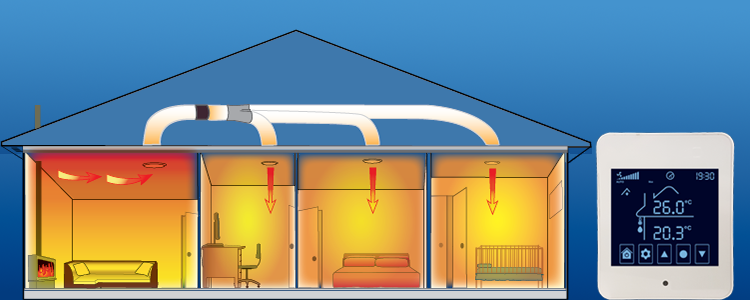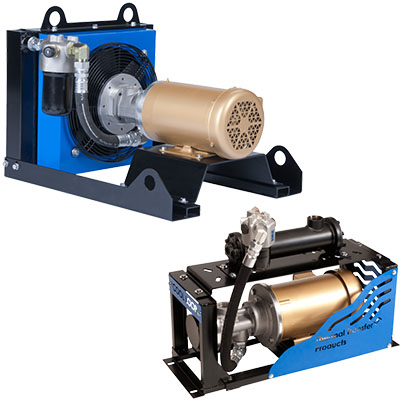The Duty of Heat Transfer Solutions in Sustainable Power Solutions for the Future
Heat transfer systems are essential in the quest for lasting power options. They enhance thermal energy management, boosting the effectiveness of renewable modern technologies. By using mechanisms like radiation, transmission, and convection, these systems decrease energy losses. Their duty in solar thermal and geothermal applications is particularly substantial. As advancements arise, the possibility for further innovations increases vital inquiries regarding future energy techniques. What advancements will shape the landscape of lasting energy?
Understanding Heat Transfer Equipments

The Importance of Thermal Power Administration
Reliable thermal energy administration is essential for maximizing energy performance and minimizing waste in different systems. By controling temperature and enhancing Heat transfer processes, companies can noticeably lower energy consumption and operational costs. Effective monitoring includes the execution of sophisticated modern technologies and techniques that check and regulate thermal conditions within systems, making certain that energy sources are utilized effectively. Furthermore, appropriate thermal energy management adds to minimizing greenhouse gas emissions, aligning with global sustainability objectives. It also boosts system dependability and performance, resulting in enhanced item quality and longer devices life-span. Ultimately, prioritizing thermal energy management is a vital step towards developing more sustainable power solutions and fostering a liable approach to energy intake in industrial and household contexts.
Applications of Heat Transfer in Renewable Energy
While different eco-friendly power sources promise sustainability, the effective application of Heat transfer plays a vital duty in their effectiveness. In wind energy systems, Heat transfer is used for generator element air conditioning, boosting efficiency and longevity. Geothermal power depends on efficient Heat exchange in between the earth's subsurface and the liquid flowing in the system, taking full advantage of power removal. Biomass energy procedures likewise gain from Heat transfer, as it assists in converting natural materials into useful gas via pyrolysis and gasification. In addition, in hydropower, preserving excellent temperatures in reservoirs can enhance power outcome. Each of these applications demonstrates the vital significance of Heat transfer systems in enhancing renewable energy innovations, eventually contributing to a more sustainable power future.
Enhancing Solar Thermal Power Performance
As solar thermal power systems proceed to progress, improving their performance has ended up being crucial for optimizing power output. Advances in Heat transfer modern technologies, such as improved thermal storage space products and innovative Heat exchangers, play a significant function in improving performance. By making use of sophisticated materials that have exceptional thermal conductivity, systems can transfer and record Heat better. In addition, integrating tracking systems that adhere to the sun's course assurances that collection agencies obtain suitable solar exposure throughout the day. Using nanotechnology in solar absorbers can better enhance energy absorption prices. Moreover, integrating automatic control systems assists control temperature levels and handle power circulation effectively, bring about lowered losses and improved overall system efficiency. These enhancements lead the method for even more lasting solar thermal power services in the future.
Geothermal Home Heating: A Lasting Solution
Geothermal home heating presents a viable option for lasting power, using considerable environmental advantages via lowered greenhouse gas discharges. Its effectiveness and cost-effectiveness make it an attractive alternative to traditional home heating systems. Nevertheless, difficulties associated to implementation must be addressed to optimize its prospective impact.
Environmental Benefits of Geothermal
Typical home heating methods contribute significantly to greenhouse gas discharges, geothermal heating offers an engaging alternative that reduces environmental impact. By using the Planet's inner Heat, geothermal systems use an eco-friendly energy resource, noticeably minimizing dependence on fossil gas. This approach generates minimal carbon exhausts, making it a cleaner alternative for commercial and property home heating. Additionally, geothermal systems advertise power efficiency, as they require less power compared to conventional furnace. DVS Heat Transfer Systems. The application of geothermal power also aids in lowering air pollution, boosting regional air top quality and public health and wellness. As a sustainable solution, geothermal home heating supports environment modification reduction efforts, placing itself as an important component in the change towards a greener future
Effectiveness and Cost-Effectiveness
Exactly how does geothermal heating measure up in regards to performance and cost-effectiveness compared to typical heating unit? Geothermal heating shows superior effectiveness, frequently attaining a coefficient of efficiency (POLICE) of 3 to 5, indicating it creates 3 to 5 units of Heat for every single system of electrical power eaten. This efficiency equates into lower operating costs, specifically in regions with secure geothermal resources. Preliminary installment costs can be greater than standard systems; nevertheless, long-term savings on energy expenses and minimized upkeep expenses can offset these upfront financial investments. Furthermore, many federal governments incentivize geothermal systems via rebates and tax obligation credit histories, boosting their cost-effectiveness. On the whole, geothermal heating emerges as a economically sensible and lasting choice to even more conventional heating remedies.
Implementation Obstacles and Solutions
Various obstacles can restrain the widespread application of geothermal furnace, in spite of their clear advantages as a lasting energy remedy. High initial installment expenses usually hinder investors and home owners, making funding a considerable barrier. Furthermore, the geographical limitations of appropriate geothermal websites limit availability in specific regions. Neighborhood laws and allowing processes can additionally make complex project growth, resulting in hold-ups. Additionally, public understanding and understanding of geothermal systems continue to be low, impeding approval. To attend to these challenges, targeted education and learning campaigns can improve open secret, while federal government motivations could ease financial worries. Collaborating with local authorities to simplify regulations might assist in smoother project authorizations, ultimately advertising the fostering of geothermal home heating as a viable, lasting energy choice.
Technologies in Heat Transfer Technologies
Innovations in Heat transfer technologies play a crucial function in boosting energy effectiveness and sustainability. Advanced Heat exchangers and stage modification products are at the forefront of these growths, using significant renovations in thermal administration. These technologies not just enhance energy usage however additionally add to lowering environmental impact in different applications.
Advanced Heat Exchangers
Advanced Heat exchangers play a necessary duty in improving energy efficiency across numerous applications in sustainable energy remedies. These gadgets facilitate the transfer of Heat in between 2 or more fluids, considerably decreasing energy usage in processes such as industrial home heating, cooling, and power generation. Technologies in products and layout, such as using nanofluids and small arrangements, have led to improved thermal performance and reduced size requirements. Additionally, advancements in digital monitoring and control systems permit optimized operation, further increasing effectiveness. By lessening waste Heat and maximizing energy recuperation, advanced Heat exchangers add to decrease carbon footprints and sustain the shift towards ecologically friendly modern technologies. Their proceeded development is important for accomplishing worldwide power sustainability objectives.
Phase Modification Products
The integration of phase change products (PCMs) right into Heat transfer modern technologies represents a substantial improvement in energy management and performance. PCMs absorb and launch thermal energy throughout their stage changes, enabling effective temperature click resources regulation in building materials and energy systems. By storing excess Heat during height periods and launching it when demand increases, PCMs add to pack changing and power conservation - DVS Heat Transfer Systems. This capacity enhances the performance of renewable resource systems, particularly in solar thermal applications. Additionally, PCMs can improve the thermal comfort of interior settings, lowering reliance on standard home heating and cooling techniques. As innovations in PCM solutions remain to emerge, their duty in lasting energy services is positioned to expand, providing encouraging opportunities for future research study and application

Future Leads for Heat Transfer in Lasting Power
As the need for lasting power remedies have a peek at these guys proceeds to rise, the function of Heat transfer systems is becoming progressively critical fit future innovations. Developments in designs and products are anticipated to improve effectiveness in Heat transfer, reducing energy losses in different applications. The integration of sophisticated thermal storage systems, such as phase change materials and thermochemical storage, will enable better administration of power sources. Study right into nanofluids and biomimetic Heat exchangers might additionally enhance thermal efficiency. The adoption of clever innovations will certainly enable for real-time monitoring and flexible control of Heat transfer procedures. These developments are poised to substantially add to the general performance and sustainability of energy systems, leading the way for a more energy-efficient future.
Regularly Asked Concerns
Just How Can Individuals Carry Out Heat Transfer Systems in the house?

People can execute Heat transfer systems in your home by installing energy-efficient home appliances, using radiant heat, and optimizing insulation. These steps enhance energy performance, reduce costs, and advertise lasting practices in residential settings.

What Are the Costs Related To Mounting Heat Transfer Systems?
The expenses connected with installing Heat transfer systems vary widely, usually encompassing equipment, setup labor, and upkeep. Variables such as system kind, home size, and regional policies considerably affect the overall expense included.
Are There Federal Government Motivations for Heat Transfer System Installations?
Federal government incentives for Heat transfer system setups vary by region and can include tax gives, discounts, and credits. These financial advantages aim to encourage adoption, eventually promoting power effectiveness and minimizing ecological effect within communities.
How Do Heat Transfer Equipments Influence Energy Costs?
Heat transfer systems significantly influence energy costs by enhancing power performance. By boosting the transfer of Heat, these systems lower energy usage, bring about lower energy expenses and creating an extra lasting technique to power monitoring.
What Maintenance Is Required for Heat Transfer Equipments?
Upkeep for Heat transfer systems includes routine examinations, cleansing of parts, checking fluid levels, making sure appropriate insulation, and replacing used components. These tasks assist maintain performance, protect against malfunctions, and prolong the system's operational life-span.
These systems assist in the motion of thermal energy from one medium to one more, allowing the transfer of Heat for power, home heating, or air conditioning generation purposes. Geothermal power counts on reliable Heat exchange in between the earth's subsurface and the liquid circulating in the system, maximizing energy removal. Additionally, geothermal systems promote energy efficiency, as they require much less power pop over here contrasted to traditional heating systems. Advanced Heat exchangers play a crucial duty in enhancing energy efficiency across different applications in sustainable power remedies. Heat transfer systems especially influence power expenses by maximizing energy performance.